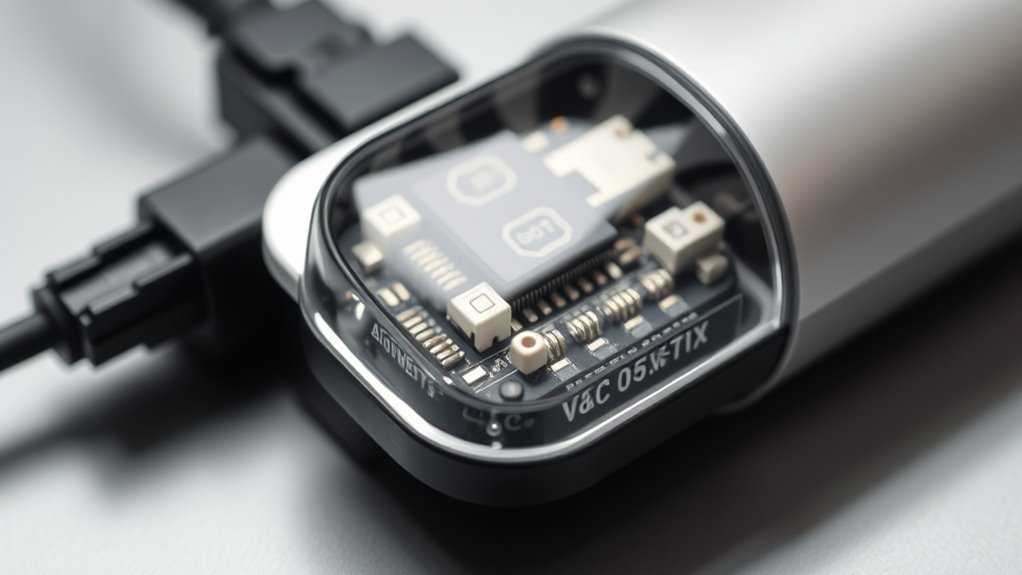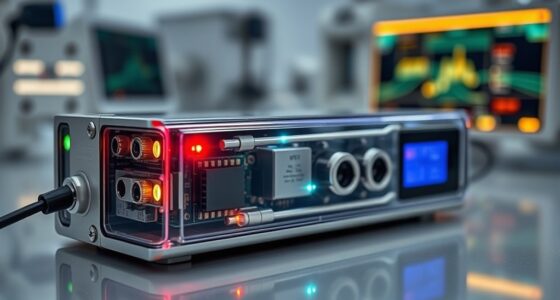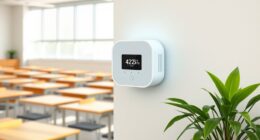VOC sensors work by detecting gases emitted from sources like paints, cleaners, or fuels. They use technologies such as photoionization detection (PID), which uses UV light to ionize VOC molecules and measure their presence, or electrochemical sensors that rely on chemical reactions at electrodes to pinpoint specific gases. Both methods require calibration to stay accurate. If you want to understand how these sensors accurately monitor air quality, keep exploring these technologies in detail.
Key Takeaways
- VOC sensors detect airborne volatile organic compounds using different technologies like photoionization and electrochemical methods.
- Photoionization sensors use UV light to ionize VOC molecules, measuring ionized particles for concentration.
- Electrochemical sensors rely on chemical reactions at electrodes, producing a current proportional to VOC levels.
- Calibration ensures sensor accuracy by adjusting responses based on known VOC standards.
- Environmental factors such as humidity, temperature, and contaminants can affect sensor performance and readings.
What Are VOC Sensors and Why Are They Important?
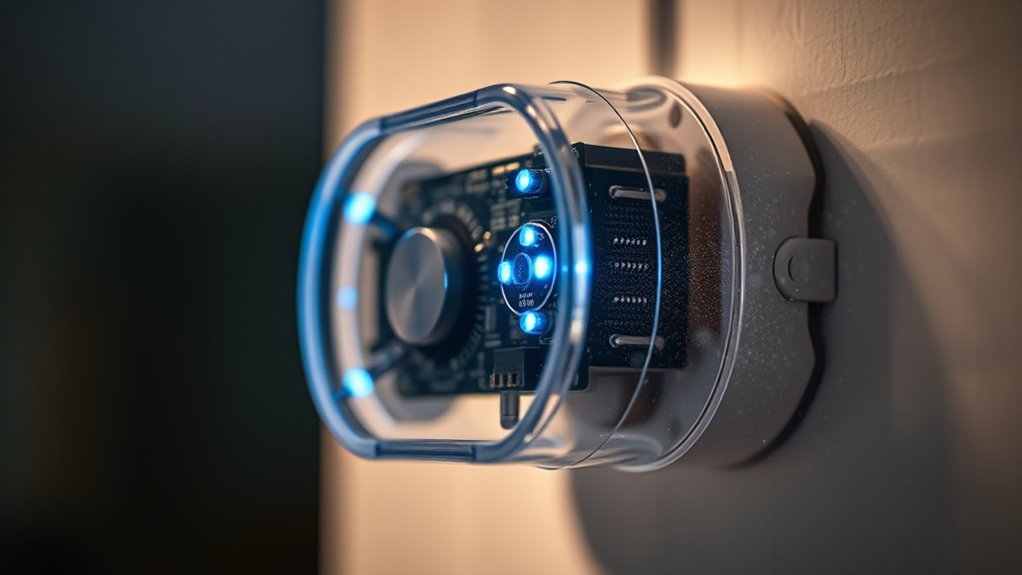
VOCs, or volatile organic compounds, are gases emitted from everyday products like cleaning supplies, paints, and fuels. VOC sensors help you monitor air quality by detecting these harmful emissions in real-time. They are essential for maintaining healthy indoor environments and ensuring safety in workplaces. Proper sensor calibration is crucial; it ensures accurate readings and reliable data over time. Without calibration, sensors can drift, giving false positives or negatives, which might lead you to overlook dangerous VOC levels. By regularly calibrating your sensors, you can trust their measurements and respond promptly to air quality issues. Additionally, understanding the role of advanced detection technologies can help improve the accuracy and reliability of VOC sensors. Overall, VOC sensors are vital tools for protecting health, improving air quality, and maintaining a safe environment in homes, offices, and industrial settings.
The Basics of Photoionization Detection (PID) Technology

Photoionization Detection (PID) technology offers a highly sensitive way to identify volatile organic compounds in the air. It works by using an ultraviolet (UV) lamp to ionize VOC molecules, creating charged particles that a sensor detects. Proper sensor calibration is vital to guarantee accurate readings, so you regularly adjust the device against known standards. This calibration helps set detection thresholds, which determine the VOC concentration levels the sensor can flag. When VOC levels exceed these thresholds, the device alerts you, allowing quick response to potential hazards. PID sensors are prized for their rapid response times and ability to detect low concentrations of VOCs. Overall, understanding sensor calibration and detection thresholds is key to effectively using PID technology for air quality monitoring. Additionally, some sensors incorporate protective styling benefits to extend their durability in various environments.
How Electrochemical Sensors Detect VOCs
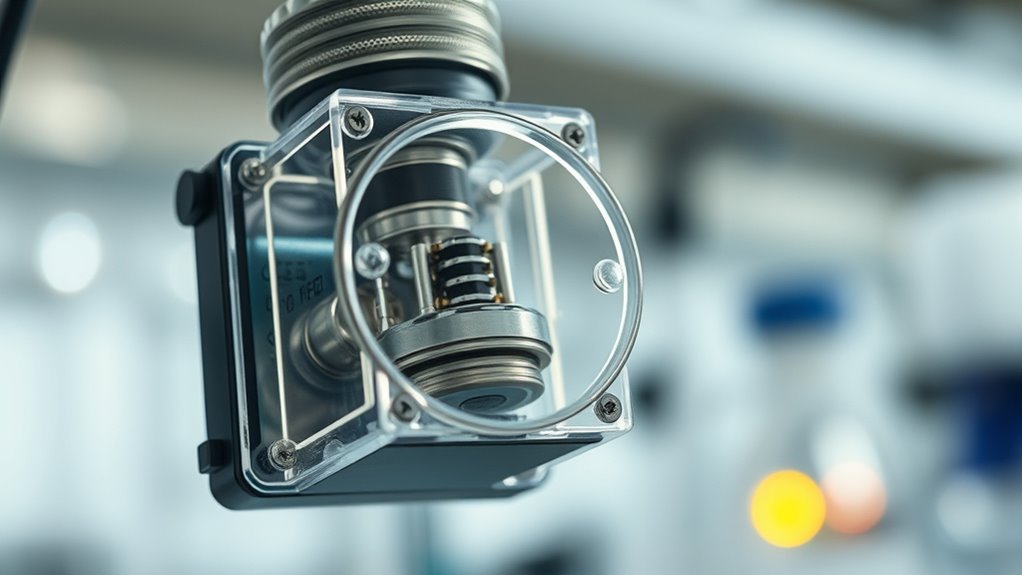
Electrochemical sensors detect VOCs through a chemical reaction at the electrode surface, producing a measurable current. The electrolyte facilitates this reaction by conducting ions between electrodes, enabling accurate sensing. This current is then converted into an electrical signal that indicates the presence and concentration of VOCs.
Sensor Reaction Mechanism
Electrochemical sensors detect VOCs through a chemical reaction that occurs at the sensor’s electrode surface. When VOC molecules reach the sensor, they undergo an oxidation or reduction reaction, generating an electrical current proportional to their concentration. To guarantee accurate readings, you need to regularly perform sensor calibration, which adjusts the sensor’s response to known VOC levels. Environmental stability plays a vital role in this process, as temperature and humidity changes can affect the reaction rate and sensor output. Proper calibration helps account for these factors, maintaining reliable detection over time. Additionally, understanding the reaction mechanism enables more precise interpretation of data and better sensor maintenance. By understanding this reaction mechanism, you can better interpret sensor data and optimize performance in various environments. This knowledge ensures your VOC detection system stays precise and consistent.
Electrolyte Role Explained
The electrolyte in an electrochemical VOC sensor plays a vital role in facilitating the detection process. It enables the movement of ions between electrodes, creating a measurable current when VOCs are present. Proper sensor calibration guarantees the electrolyte functions accurately over time, maintaining reliable readings. Regular maintenance procedures, such as checking electrolyte levels and replacing if necessary, help prevent drift and prolong sensor life. If the electrolyte depletes or becomes contaminated, your sensor’s sensitivity decreases, leading to inaccurate results. By keeping up with calibration and maintenance, you ensure the electrolyte remains effective, allowing your sensor to detect VOCs precisely. This careful management is essential for consistent performance and dependable air quality monitoring. Automation technologies are increasingly integrated into sensor systems to enhance accuracy and operational efficiency.
Signal Conversion Process
When VOCs interact with the sensor’s electrolyte, chemical reactions occur at the electrodes, producing a flow of electrons that creates an electrical signal. This signal is then sent to the sensor’s processing unit for interpretation. To guarantee accurate readings, you need proper sensor calibration, which aligns the sensor’s output with known VOC concentrations. The process involves three key steps:
- Signal Amplification: The weak electrical current is boosted for clearer detection.
- Signal Filtering: Noise is removed to improve accuracy.
- Signal Processing: The refined data is analyzed to determine VOC concentration levels.
This process transforms the raw electrochemical response into meaningful data, allowing you to monitor VOC levels precisely. Proper calibration and signal processing are essential for reliable sensor performance and accurate VOC detection. Additionally, understanding the importance of security measures in sensor deployment helps protect sensitive data from cyber threats.
Comparing Photoionization and Electrochemical Methods

When comparing photoionization and electrochemical methods, you’ll notice they rely on different detection principles—ionization versus chemical reactions. These differences impact their sensitivity and selectivity, making each better suited for specific applications. Understanding these distinctions helps you choose the right sensor for accurate VOC detection. Additionally, awareness of AI security vulnerabilities ensures the safe deployment of these sensors in critical environments.
Detection Principles Differences
Understanding how VOC sensors detect gases involves examining the fundamental differences between photoionization and electrochemical methods. Photoionization sensors use high-energy UV light to ionize VOC molecules, generating a current proportional to their concentration. In contrast, electrochemical sensors rely on chemical reactions within an electrolyte, producing a measurable electrical signal. When comparing detection principles, consider these key points:
- Calibration techniques differ: photoionization sensors need UV lamp calibration, while electrochemical sensors require regular electrolyte checks.
- Environmental influences impact performance: humidity and temperature affect electrochemical sensors more, whereas photoionization sensors are sensitive to light interference.
- Response times vary: photoionization provides quick detection, whereas electrochemical sensors may need more time to stabilize.
- Proper maintenance and understanding of sensor types ensure accurate and reliable measurements.
Knowing these differences helps you select the right sensor, considering environmental conditions and calibration needs.
Sensitivity and Selectivity
Both photoionization and electrochemical sensors exhibit different strengths and limitations when it comes to sensitivity and selectivity. Photoionization sensors are highly sensitive to a wide range of VOCs, but environmental influences like humidity and temperature can affect their accuracy, requiring regular sensor calibration. Electrochemical sensors offer good selectivity for specific gases, which makes them suitable for targeted detection, but their sensitivity can be limited by aging and environmental factors. While photoionization devices detect VOCs based on ionization efficiency, electrochemical sensors rely on chemical reactions at the electrode surface. To maintain reliable performance, understanding these differences helps you choose the right sensor and guarantees proper calibration, especially in environments with fluctuating conditions. Additionally, factors such as sensor material can influence the durability and responsiveness of VOC sensors over time.
Factors Influencing Sensor Accuracy and Performance

Several factors can important impact the accuracy and performance of VOC sensors, making it essential to think about them carefully. First, sensor calibration is crucial; regular calibration ensures readings remain accurate over time. Second, environmental factors like temperature, humidity, and air flow can affect sensor responses, causing inconsistent results. Third, sensor aging and exposure to contaminants can degrade performance, leading to drift and false readings. To optimize accuracy, you should routinely calibrate your sensor, monitor environmental conditions, and keep sensors clean and protected from harsh elements. Additionally, choosing a home theatre projector with reliable performance features can help ensure consistent operation in various settings. Understanding these factors helps you maintain reliable measurements and extend your sensor’s lifespan, guaranteeing that your VOC detection remains precise and effective.
Applications of VOC Sensors in Real-World Settings
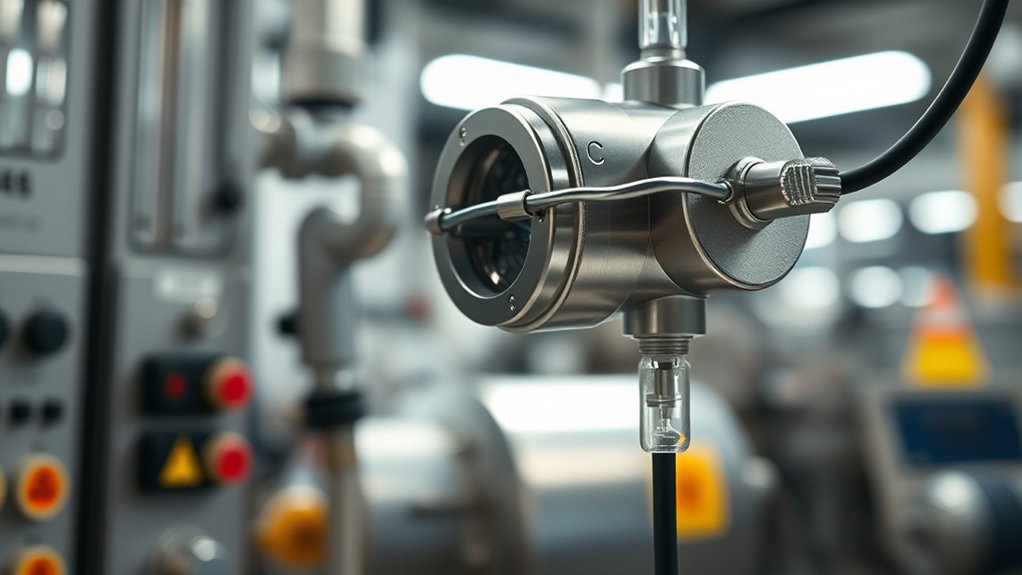
VOC sensors are widely used across various industries to monitor air quality and guarantee safety. In indoor air environments, these sensors detect harmful VOCs from household products, cleaning agents, or building materials, helping maintain healthy indoor air quality. They enable quick identification of elevated VOC levels, allowing you to take immediate action to improve air conditions. In industrial safety settings, VOC sensors play a critical role in preventing dangerous exposures to hazardous chemicals. They are integrated into safety systems to continuously monitor air for leaks or spills, alerting personnel before concentrations reach harmful levels. By providing real-time data, VOC sensors help assure compliance with safety regulations and protect workers from health risks, making them essential tools in both indoor environments and industrial safety protocols. Additionally, advancements in sensor technology have increased the accuracy and reliability of VOC detection, further enhancing their effectiveness in safeguarding health.
Choosing the Right VOC Sensor for Your Needs

Choosing the right VOC sensor depends on your specific monitoring needs, environment, and budget. To make an informed choice, consider these key factors:
Selecting the ideal VOC sensor requires assessing your monitoring needs, environment, and budget for optimal results.
- Sensor calibration: Guarantee the sensor can be easily calibrated for accurate readings over time, especially in dynamic environments.
- Device durability: Opt for sensors designed to withstand your working conditions, whether it’s harsh chemicals or extreme temperatures.
- Technology type: Decide between photoionization and electrochemical sensors based on detection range, sensitivity, and maintenance requirements.
- Maintenance considerations: Be aware of the sensor lifespan and the need for regular calibration and replacement to ensure ongoing accuracy.
Frequently Asked Questions
How Do Environmental Conditions Affect VOC Sensor Readings?
Environmental conditions directly impact your VOC sensor readings by affecting air quality and sensor sensitivity. High humidity or temperature fluctuations can cause inaccurate readings or delays in detection. Poor air circulation may lead to stagnant air, skewing results. To guarantee reliable data, you should regularly calibrate your sensors and position them in well-ventilated areas. Monitoring environmental factors helps you maintain precise VOC detection and overall air quality assessment.
What Maintenance Is Required for Long-Term Sensor Accuracy?
Did you know that regular maintenance can extend VOC sensor lifespan by up to 50%? To keep your sensor accurate, you should perform sensor calibration annually and check for dirt or damage. Additionally, optimize power management to prevent overheating and guarantee consistent performance. These steps help maintain precise readings over time, reducing false alarms and costly replacements, ultimately ensuring your VOC sensor stays reliable in the long run.
Can VOC Sensors Differentiate Between Different Chemical Compounds?
You might wonder if VOC sensors can differentiate between chemical compounds. While some advanced sensors offer chemical specificity, most are designed for sensor differentiation of broad VOC groups rather than specific chemicals. This means they detect the presence of VOCs generally, but may not identify individual compounds precisely. If chemical specificity is essential, consider specialized sensors or additional analytical methods to accurately distinguish between different chemical compounds.
What Are the Limitations of Photoionization Sensors?
Did you know that photoionization sensors can struggle with 30% of VOCs in certain environments? Their limitations include reduced sensor sensitivity for low concentrations and a limited detection range for specific compounds. These sensors may also give false readings due to humidity or interference from other gases. Understanding these constraints helps you choose the right sensor for your needs, ensuring accurate detection and safety.
How Do Sensor Lifespan and Calibration Impact Performance?
You need to take into account how sensor lifespan and calibration impact your VOC sensor’s performance. As sensors age, they experience sensor drift, which reduces accuracy over time. Regular calibration, often dictated by calibration frequency, helps correct this drift and maintain reliable readings. Neglecting calibration or using an aged sensor can lead to inaccurate data, compromising safety and decision-making. Consistent maintenance ensures your sensor stays precise and functions effectively.
Conclusion
Imagine a tiny sentinel, tirelessly scanning the air around you, whether in a bustling lab or a smoky room. VOC sensors, using photoionization or electrochemical tech, act as your vigilant eyes, detecting unseen dangers. They transform invisible threats into clear, actionable data, ensuring safety and peace of mind. With the right sensor, you hold the power to navigate environments confidently, turning silent threats into understood allies. Trust in their accuracy to keep you safe every breath of the way.
